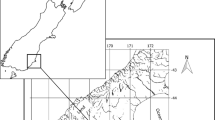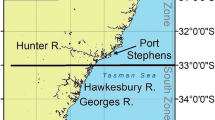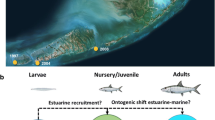Abstract
The Gulf killifish, Fundulus grandis, is a vital component of saltmarsh ecosystems and an indicator species for environmental impacts, because of strong site fidelity. Also, their otoliths can provide a record of environmental conditions because they are metabolically inert, grow continuously with the fish, and incorporate trace elements from the environment. We used laser ablation inductively coupled plasma mass spectrometry (LA-ICP-MS) to determine chemical composition differences in Gulf killifish otoliths across the northern Gulf of Mexico. Fish collections started in fall 2012 and continued through summer 2013. Concentrations of Mn, Sr, and Ba varied among sites and allowed for discrimination of fish between estuaries in Louisiana (elevated Ba concentrations) and the west side of Mobile Bay, Alabama (elevated Mn concentrations). However, elemental signatures of otoliths from Mississippi, Florida, and the east side of Alabama could not be discriminated from one another. Regional differences in otolith elemental signatures in Louisiana and west Alabama appear to provide unique chemical tags for these waters and, thus, may have utility for nursery habitat determination for species with estuarine-dependent juveniles. Otoliths of F. grandis that had been exposed to oil (either from the 2010 Deepwater Horizon oil spill or because of close proximity to an oil refinery) did not differ in elemental signature between paired oiled and non-oiled sites. Therefore, the otoliths did not contain trace metals associated with oil. Also, the relative condition of F. grandis did not differ between paired sites. The presence of F. grandis at all sites, the lack of effect of oiling on relative condition, and no signal of oil-related elements in the otoliths suggest minimal long-term impact of the Deepwater Horizon oil spill on F. grandis.












Similar content being viewed by others
References
Abbriano, R.M., M.M. Carranza, S.L. Hogle, R.A. Levin, A.N. Netburn, K.L. Seto, S.M. Snyder, and P.J.S. Franks. 2011. Deepwater Horizon oil spill: a review of the planktonic response. Oceanography 24: 294–301.
Able, K.W., S.M. Hagan, and S.A. Brown. 2006. Habitat use, movement, and growth of young-of-the-year Fundulus spp. in southern New Jersey salt marshes: comparisons based on tag/recapture. Journal of Experimental Marine Biology and Ecology 335: 177–187.
Albuquerque, C.Q., N. Miekeley, J.H. Muelbert, B.D. Walther, and A.J. Jaureguizar. 2012. Estuarine dependency in a marine fish evaluated with otolith chemistry. Marine Biology 159: 2229–2239.
Ashford, J., and C. Jones. 2007. Oxygen and carbon stable isotopes in otoliths record spatial isolation of Patagonian toothfish (Dissostichus eleginoides). Geochimica Et Cosmochimica Acta 71: 87–94.
Bath, G.E., S.R. Thorrold, C.M. Jones, S.E. Campana, J.W. McLaren, and J.W.H. Lam. 2000. Strontium and barium uptake in aragonitic otoliths of marine fish. Geochimica Et Cosmochimica Acta 64: 1705–1714.
Bradbury, I.R., S.E. Campana, and P. Bentzen. 2008. Estimating contemporary early life-history dispersal in an estuarine fish: integrating molecular and otolith elemental approaches. Molecular Ecology 17: 1438–1450.
Brazner, J.C., S.E. Campana, and D.K. Tanner. 2004. Habitat fingerprints for Lake Superior coastal wetlands derived from elemental analysis of yellow perch otoliths. Transactions of the American Fisheries Society 133: 692–704.
Brownie, C., and D.D. Boos. 1994. Type I error robustness of ANOVA and ANOVA on ranks when the number of treatments is large. Biometrics 50: 542–549.
Buckel, J.A., B.L. Sharack, and V.S. Zdanowicz. 2004. Effect of diet on otolith composition in Pomatomus saltatrix, an estuarine piscivore. Journal of Fish Biology 64: 1469–1484.
Camilli, R., C.M. Reddy, D.R. Yoerger, B.A.S. Van Mooy, M.V. Jakuba, J.C. Kinsey, C.P. McIntyre, S.P. Sylva, and J.V. Maloney. 2010. Tracking hydrocarbon plume transport and biodegradation at Deepwater Horizon. Science 330: 201–204.
Campana, S.E. 1999. Chemistry and composition of fish otoliths: pathways, mechanisms and applications. Marine Ecology Progress Series 188: 263–297.
Campana, S.E., and J.D. Neilson. 1985. Microstructure of fish otoliths. Canadian Journal of Fisheries and Aquatic Sciences 42: 1014–1032.
Campana, S.E., and S.R. Thorrold. 2001. Otoliths, increments, and elements: keys to a comprehensive understanding of fish populations? Canadian Journal of Fisheries and Aquatic Sciences 58: 30–38.
Campana, S.E., A.J. Fowler, and C.M. Jones. 1994. Otolith elemental fingerprinting for stock identification of Atlantic cod (Gadus morhua) using laser-ablation ICPMS. Canadian Journal of Fisheries and Aquatic Sciences 51: 1942–1950.
Campana, S.E., G.A. Chouinard, J.M. Hanson, A. Frechet, and J. Brattey. 2000. Otolith elemental fingerprints as biological tracers of fish stocks. Fisheries Research 46: 343–357.
Carmichael, R.H., A.L. Jones, H.K. Patterson, W.C. Walton, A. Perez-Huerta, E.B. Overton, M. Dailey, and K.L. Willett. 2012. Assimilation of oil-derived elements by oysters due to the Deepwater Horizon oil spill. Environmental Science & Technology 46: 12787–12795.
Coffey, M., F. Dehairs, O. Collette, G. Luther, T. Church, and T. Jickells. 1997. The behaviour of dissolved barium in estuaries. Estuarine, Coastal and Shelf Science 45: 113–121.
Courtenay, S.C., K.R. Munkittrick, H.M.C. Dupuis, R. Parker, and J. Boyd. 2002. Quantifying impacts of pulp mill effluent on fish in Canadian marine and estuarine environments: problems and progress. Water Quality Research Journal of Canada 37: 79–99.
De Almeida, C.M.S., A.S. Ribeiro, T.D. Saint’Pierre, and N. Miekeley. 2009. Studies on the origin and transformation of selenium and its chemical species along the process of petroleum refining. Spectrochimica Acta Part B: Atomic Spectroscopy 64: 491–499.
Dibble, K.L., and L.A. Meyerson. 2012. Tidal flushing restores the physiological condition of fish residing in degraded salt marshes. Plos One 7: e46161. doi:10.1371/journal.pone.0046161.
Dibble, K.L., and L.A. Meyerson. 2014. The effects of plant invasion and ecosystem restoration on energy flow through salt marsh food webs. Estuaries and Coasts 37: 339–353.
Doubleday, Z.A., H.H. Harris, C. Izzo, and B.M. Gillanders. 2014. Strontium randomly substituting for calcium in fish otolith aragonite. Analytical Chemistry 86: 865–869.
Ellis, J., C. Rechsteiner, M. Moir, and S. Wilbur. 2011. Determination of volatile nickel and vanadium species in crude oil and crude oil fractions by gas chromatography coupled to inductively coupled plasma mass spectrometry. Journal of Analytical Atomic Spectrometry 26: 1674–1678.
Farmer, T.M., D.R. DeVries, R.A. Wright, and J.E. Gagnon. 2013. Using seasonal variation in otolith microchemical composition to indicate largemouth bass and southern flounder residency patterns across an estuarine salinity gradient. Transactions of the American Fisheries Society 142: 1415–1429.
Farrell, J., and S.E. Campana. 1996. Regulation of calcium and strontium deposition on the otoliths of juvenile tilapia, Oreochromis niloticus. Comparative Biochemistry and Physiology. Part A, Physiology 115: 103–109.
Ferguson, G.J., T.M. Ward, and B.M. Gillanders. 2011. Otolith shape and elemental composition: Complementary tools for stock discrimination of mulloway (Argyrosomus japonicus) in southern Australia. Fisheries Research 110: 75–83.
Finley, M.A., S.C. Courtenay, K.L. Teather, and M.R. van den Heuvel. 2009. Assessment of northern mummichog (Fundulus heteroclitus macrolepidotus) as an estuarine pollution monitoring species. Water Quality Research Journal of Canada 44: 323–332.
Fodrie, F.J., and K.L. Heck. 2011. Response of coastal fishes to the Gulf of Mexico oil disaster. Plos One 6: e21609. doi:10.1371/journal.pone.0021609.
Fritz, E.S., and E.T. Garside. 1975. Comparison of age composition, growth, and fecundity between 2 populations each of Fundulus heteroclitus and Fundulus diaphanus (Pisces-Cyprinodontidae). Canadian Journal of Zoology-Revue Canadienne De Zoologie 53: 361–369.
Gillanders, B.M., and M.J. Kingsford. 2003. Spatial variation in elemental composition of otoliths of three species of fish (family Sparidae). Estuarine, Coastal and Shelf Science 57: 1049–1064.
Gonzalez, I., M. Levin, S. Jermanus, B. Watson, and M.R. Gilg. 2009. Genetic assessment of species ranges in Fundulus heteroclitus and F-grandis in northeastern Florida salt marshes. Southeastern Naturalist 8: 227–244.
Greeley, M.S., and R. MacGregor. 1983. Annual and semilunar reproductive cycles of the gulf killifish, Fundulus grandis, on the Alabama gulf coast. Copeia 3: 711–718.
Grosser, Z.A., D. Bass, L. Foglio, and L. Davidowski. 2012. Determination of metals as markers oil. Contamination in seafood by ICP-MS. Agro Food Industry Hi-Tech 23: 24–26.
Hanor, J.S., and L.H. Chan. 1977. Non-conservative behavior of barium during mixing of Mississippi River and Gulf of Mexico waters. Earth and Planetary Science Letters 37: 242–250.
Kahn, A., and G.D. Rayner. 2003. Robustness to non-normality of common tests for the many-sample location problem. Journal of Applied Mathematics and Decision Sciences 7: 187–206.
Kennedy, B.P., J.D. Blum, C.L. Folt, and K.H. Nislow. 2000. Using natural strontium isotopic signatures as fish markers: methodology and application. Canadian Journal of Fisheries and Aquatic Sciences 57: 2280–2292.
Kneib, R.T., and A.E. Stiven. 1978. Growth, reproduction, and feeding of Fundulus heteroclitus (L) on a North Carolina salt marsh. Journal of Experimental Marine Biology and Ecology 31: 121–140.
Limburg, K.E., B.D. Walther, Z. Lu, G. Jackman, J. Mohan, Y. Walther, A. Nissling, P.K. Weber, and A.K. Schmitt. 2014. In search of the dead zone: use of otoliths for tracking fish exposure to hypoxia. Journal of Marine Systems. doi:10.1016/j.jmarsys.2014.02.014.
Liu, Z. F., J. Q. Liu, Q. Z. Zhu, and W. Wu. 2012. The weathering of oil after the Deepwater Horizon oil spill: insights from the chemical composition of the oil from the sea surface, salt marshes and sediments. Environmental Research Letters 7. doi:10.1088/1748-9326/1087/1083/035302
Longerich, H.P., S.E. Jackson, and D. Gunther. 1996. Laser ablation inductively coupled plasma mass spectrometric transient signal data acquisition and analyte concentration calculation. Journal of Analytical Atomic Spectrometry 11: 899–904.
Longmore, C., K. Fogarty, F. Neat, D. Brophy, C. Trueman, A. Milton, and S. Mariani. 2010. A comparison of otolith microchemistry and otolith shape analysis for the study of spatial variation in a deep-sea teleost, Coryphaenoides rupestris. Environmental Biology of Fishes 89: 591–605.
Lotrich, V.A. 1975. Summer home range and movements of Fundulus heteroclitus (Pisces Cyprinodontidae) in a tidal creek. Ecology 56: 191–198.
Lowe, M.R., D.R. DeVries, R.A. Wright, S.A. Ludsin, and B.J. Fryer. 2009. Coastal largemouth bass (Micropterus salmoides) movement in response to changing salinity. Canadian Journal of Fisheries and Aquatic Sciences 66: 2174–2188.
Lowe, M.R., D.R. DeVries, R.A. Wright, S.A. Ludsin, and B.J. Fryer. 2011. Otolith microchemistry reveals substantial use of freshwater by southern flounder in the northern Gulf of Mexico. Estuaries and Coasts 34: 630–639.
Ludden, J.N., R. Feng, G. Gauthier, J. Stix, L. Shi, D. Francis, N. Machado, and G.P. Wu. 1995. Applications of LAM-ICP-MS analysis to minerals. Canadian Mineralogist 33: 419–434.
Ludsin, S.A., B.J. Fryer, and J.E. Gagnon. 2006. Comparison of solution-based versus laser ablation inductively coupled plasma mass spectrometry for analysis of larval fish otolith microelemental composition. Transactions of the American Fisheries Society 135: 218–231.
Melancon, S., B.J. Fryer, J.E. Gagnon, and S.A. Ludsin. 2008. Mineralogical approaches to the study of biomineralization in fish otoliths. Mineralogical Magazine 72: 627–637.
Miekeley, N., R.C. Pereira, E.A. Casartelli, A.C. Almeida, and M.D. Carvalho. 2005. Inorganic speciation analysis of selenium by ion chromatography-inductively coupled plasma-mass spectrometry and its application to effluents from a petroleum refinery. Spectrochimica Acta Part B: Atomic Spectroscopy 60: 633–641.
Moody, R.M., J. Cebrian, and K.L. Heck Jr. 2013. Interannual recruitment dynamics for resident and transient marsh species: evidence for a lack of impact by the Macondo oil spill. Plos One 8: e58376. doi:10.1371/journal.pone.0058376.
Morales-Nin, B., S.C. Swan, J.D.M. Gordon, M. Palmer, A.J. Geffen, T. Shimmield, and T. Sawyer. 2005. Age-related trends in otolith chemistry of Merluccius merluccius from the north-eastern Atlantic Ocean and the western Mediterranean Sea. Marine and Freshwater Research 56: 599–607.
Morales-Nin, B., A.J. Geffen, F. Cardona, C. Kruber, and F. Saborido-Rey. 2007. The effect of Prestige oil ingestion on the growth and chemical composition of turbot otoliths. Marine Pollution Bulletin 54: 1732–1741.
Nelson, T.R., D. Sutton, and D. DeVries. 2014. Summer movements of the Gulf Killifish (Fundulus grandis) in a northern Gulf of Mexico salt marsh. Estuaries and Coasts. doi:10.1007/s12237-12013-19762-12235.
Neumann, R.M., C.S. Guy, and D.W. Willis. 2012. Length, weight, and associated indices. In Fisheries techniques, 3rd ed, ed. A.V. Zale, D.L. Parrish, and T.M. Sutton, 637–676. Bethesda, Maryland: American Fisheries Society.
Niklitschek, E.J., D.H. Secor, P. Toledo, A. Lafon, and M. George-Nascimento. 2010. Segregation of SE Pacific and SW Atlantic southern blue whiting stocks: integrating evidence from complementary otolith microchemistry and parasite assemblage approaches. Environmental Biology of Fishes 89: 399–413.
Oros, D.R., J.R.M. Ross, R.B. Spies, and T. Mumley. 2007. Polycyclic aromatic hydrocarbon (PAH) contamination in San Francisco Bay: a 10-year retrospective of monitoring in an urbanized estuary. Environmental Research 105: 101–118.
Reay, W.G. 2009. Water quality within the York River estuary. Journal of Coastal Research 57: 23–39.
Rooker, J.R., R.T. Kraus, and D.H. Secor. 2004. Dispersive behaviors of black drum and red drum: is otolith Sr : Ca a reliable indicator of salinity history? Estuaries 27: 334–341.
Rooker, J.R., L.L. Kitchens, M.A. Dance, R.J.D. Wells, B. Falterman, and M. Cornic. 2013. Spatial, temporal, and habitat-related variation in abundance of pelagic fishes in the Gulf of Mexico: potential implications of the Deepwater Horizon oil spill. Plos One 8: e76080. doi:10.1371/journal.pone.0076080.
Rozas, L.P., and M.W. LaSalle. 1990. A comparison of the diets of gulf killifish, Fundulus grandis Baird and Girard, entering and leaving a Mississippi brackish marsh. Estuaries 13: 332–336.
Rozas, L.P., and D.J. Reed. 1993. Nekton use of marsh-surface habitats in Louisiana (USA) deltaic salt marshes undergoing submergence. Marine Ecology-Progress Series 96: 147–157.
Rozas, L.P., and R.J. Zimmerman. 2000. Small-scale patterns of nekton use among marsh and adjacent shallow nonvegetated areas of the Galveston Bay Estuary, Texas (USA). Marine Ecology-Progress Series 193: 217–239.
Ruttenberg, B.I., S.L. Hamilton, M.J.H. Hickford, G.L. Paradis, M.S. Sheehy, J.D. Standish, O. Ben-Tzvi, and R.R. Warner. 2005. Elevated levels of trace elements in cores of otoliths and their potential for use as natural tags. Marine Ecology Progress Series 297: 273–281.
Shaheen, M., J.E. Gagnon, Z. Yang, and B.J. Fryer. 2008. Evaluation of the analytical performance of femtosecond laser ablation inductively coupled plasma mass spectrometry at 785 nm with glass reference materials. Journal of Analytical Atomic Spectrometry 23: 1610–1621.
Shaw, R.G., and T. Mitchellolds. 1993. ANOVA for unbalanced data—an overview. Ecology 74: 1638–1645.
Sohn, D., S. Kang, and S. Kim. 2005. Stock identification of chum salmon (Oncorhynchus keta) using trace elements in otoliths. Journal of Oceanography 61: 305–312.
Speed, F.M., R.R. Hocking, and O.P. Hackney. 1978. Methods of analysis of linear-models with unbalanced data. Journal of the American Statistical Association 73: 105–112.
Statham, P.J. 2012. Nutrients in estuaries—an overview and the potential impacts of climate change. Science of the Total Environment 434: 213–227.
Sturrock, A.M., C.N. Trueman, A.M. Darnaude, and E. Hunter. 2012. Can otolith elemental chemistry retrospectively track migrations in fully marine fishes? Journal of Fish Biology 81: 766–795.
Szedlmayer, S.T., and P.A. Mudrak. 2014. Influence of age-1 conspecifics, sediment type, dissolved oxygen, and the Deepwater Horizon oil spill on the recruitment of age-0 red snapper in the Northeast Gulf of Mexico during 2010 and 2011. North American Journal of Fisheries Management 34: 443–452.
Tanner, S.E., R.P. Vasconcelos, P. Reis-Santos, H.N. Cabral, and S.R. Thorrold. 2011. Spatial and ontogenetic variability in the chemical composition of juvenile common sole (Solea solea) otoliths. Estuarine, Coastal and Shelf Science 91: 150–157.
Teo, S.L.H., and K.W. Able. 2003. Habitat use and movement of the mummichog (Fundulus heteroclitus) in a restored salt marsh. Estuaries 26: 720–730.
Thorrold, S.R., C.M. Jones, P.K. Swart, and T.E. Targett. 1998. Accurate classification of juvenile Weakfish Cynoscion regalis to estuarine nursery areas based on chemical signatures in otoliths. Marine Ecology-Progress Series 173: 253–265.
Vasconcelos, R.P., P. Reis-Santos, S. Tanner, V. Fonseca, C. Latkoczy, D. Gunther, M.J. Costa, and H. Cabral. 2007. Discriminating estuarine nurseries for five fish species through otolith elemental fingerprints. Marine Ecology-Progress Series 350: 117–126.
Walther, B.D., and K.E. Limburg. 2012. The use of otolith chemistry to characterize diadromous migrations. Journal of Fish Biology 81: 796–825.
Walther, B.D., and S.R. Thorrold. 2006. Water, not food, contributes the majority of strontium and barium deposited in the otoliths of a marine fish. Marine Ecology-Progress Series 311: 125–130.
Walther, B.D., T. Dempster, M. Letnic, and M.T. McCulloch. 2011. Movements of diadromous fish in large unregulated tropical rivers inferred from geochemical tracers. Plos One 6(4): e18351. doi:10.1371/journal.pone.0018351.
Wang, Y., X. Li, B.H.H. Li, Z.Y.Y. Shen, C.H.H. Feng, and Y.X.X. Chen. 2012. Characterization, sources, and potential risk assessment of PAHs in surface sediments from nearshore and farther shore zones of the Yangtze estuary, China. Environmental Science and Pollution Research 19: 4148–4158.
Ward, J.H. 1963. Hierarchical grouping to optimize an objective function. Journal of the American Statistical Association 58: 236–244.
Whitehead, A. 2010. The evolutionary radiation of diverse osmotolerant physiologies in killifish (Fundulus sp.). Evolution 64: 2070–2085.
Whitehead, A., B. Dubansky, C. Bodinier, T.I. Garcia, S. Miles, C. Pilley, V. Raghunathan, J.L. Roach, N. Walker, R.B. Walter, C.D. Rice, and F. Galvez. 2012. Genomic and physiological footprint of the Deepwater Horizon oil spill on resident marsh fishes. Proceedings of the National Academy of Sciences 109: 20298–20302.
Wishart, D. 1969. An algorithm for hierarchical classifications. Biometrics 25: 165–170.
Wolff, B.A., B.M. Johnson, A.R. Breton, P.J. Martinez, and D.L. Winkelman. 2012. Origins of invasive piscivores determined from the strontium isotope ratio (Sr-87/Sr-86) of otoliths. Canadian Journal of Fisheries and Aquatic Sciences 69: 724–739.
Zeigler, J.M., and G.W. Whitledge. 2010. Otolith trace element and stable isotopic compositions differentiate fishes from the Middle Mississippi River, its tributaries, and floodplain lakes. Hydrobiologia 661: 289–302.
Acknowledgments
We would like to thank Dr. Ash Bullard for the help with site selection and sampling protocol. We would also like to thank all of the people who helped with fish collections, Adrian Stanfill, Emily DeVries, Brooke Merrill, Carl Klimah, Jenny Herbig, Danielle Horn, Jay Foster, and Kyle Gallagher. Special thanks go to Tammy DeVries for spending countless hours pulling miniscule otoliths out of killifish and having to deal with strong H2O2 for cleaning purposes. Finally, we would like to thank Dr. Mohamed Shaheen of the University of Windsor GLIER for the help with the LA-ICP-MS. Funding for this research was provided by British Petroleum.
Author information
Authors and Affiliations
Corresponding author
Additional information
Communicated by Lawrence P. Rozas
Electronic supplementary material
Below is the link to the electronic supplementary material.
Supplementary Table 1
(DOCX 18 kb)
Rights and permissions
About this article
Cite this article
Nelson, T.R., DeVries, D.R., Wright, R.A. et al. Fundulus grandis Otolith Microchemistry as a Metric of Estuarine Discrimination and Oil Exposure. Estuaries and Coasts 38, 2044–2058 (2015). https://doi.org/10.1007/s12237-014-9934-y
Received:
Revised:
Accepted:
Published:
Issue Date:
DOI: https://doi.org/10.1007/s12237-014-9934-y




